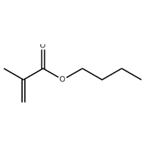What is the difference between butyl methacrylate and poly(butyl methacrylate)?
May 13,2024
What is Butyl methacrylate?
Butyl methacrylate (BMA), also known as N-Butyl methacrylate (n-BMA), is a versatile polymer monomer. The glass transition temperature (Tg) of n-BMA is 20°C. Its structure consists of polymerisable methacrylate functional groups and reactive ester groups, which are soluble in most organic solvents and can be easily copolymerised with a wide range of monomers. It can be used as a copolymer component in the preparation of inks, copier toners, adhesives, architectural and industrial exterior coatings, overprint varnishes, automotive finishes and paints, wood coatings, floor polishes, paper and leather coatings, and textile adhesives.

N-BMA possesses flexibility, durability, moisture resistance and UV/weathering resistance. It is also commonly copolymerised with methyl methacrylate, which improves the flexibility and toughness of polymethylmethacrylate (PMMA), provides excellent transparency and high gloss, and dissolves quickly in solvents. Copolymerisation with polymethylmethacrylate (PMMA) improves toughness without the addition of plasticisers to reduce UV/weathering resistance.
What is Poly(butyl methacrylate)?
Poly(butyl methacrylate) (PBMA) is a highly biocompatible polymer. PBMA has a Tg of +20%, a tensile strength of about 500 psi, and an elongation of over 300%. PBMA is used as a plasticiser and adhesion promoter for harder resins. The homopolymer is compatible with PVC resins, epoxy and alkyd resins, cellulose acetate butyrate and nitrocellulose, and rosin ester resins. Homopolymers are added to harder resin systems in order to improve toughness, flexibility, adhesion, durability and softness. Since PMMAs typically require plasticisation, plasticisation with homopolymer PBMAs can show improved outdoor weathering properties compared to other types of plasticisers. PBMA has good resistance to yellowing.
Both BMA and PBMA have similar properties, improving flexibility, durability and resistance to yellowing. The difference is that PBMA has good biocompatibility and can be widely used in drug delivery coatings.
- Related articles
- Related Qustion
Fenbendazole, a benzimidazole anthelmintic, is extensively used in veterinary medicine for the treatment of parasitic infections.....
May 13,2024APIAmmonium formate (E 295) is presently listed in the EU Register of Feed Additives as a technological additive (functional group: preservatives) for use in feed for all animal species without a time limit.....
May 13,2024Inorganic saltsButyl methacrylate
97-88-1You may like
Butyl methacrylate manufacturers
- Butyl methacrylate
-

- $0.00 / 200Kg/Drum
- 2024-05-31
- CAS:97-88-1
- Min. Order: 1KG
- Purity: 99%
- Supply Ability: 3000mt/year
- Butyl methacrylate
-

- $1.00 / 1kg
- 2024-05-30
- CAS:97-88-1
- Min. Order: 10kg
- Purity: 97%
- Supply Ability: 3000tons
- Butyl methacrylate
-

- $2123.00 / 1ton
- 2024-05-30
- CAS:97-88-1
- Min. Order: 1ton
- Purity: 99%
- Supply Ability: 5000ton




